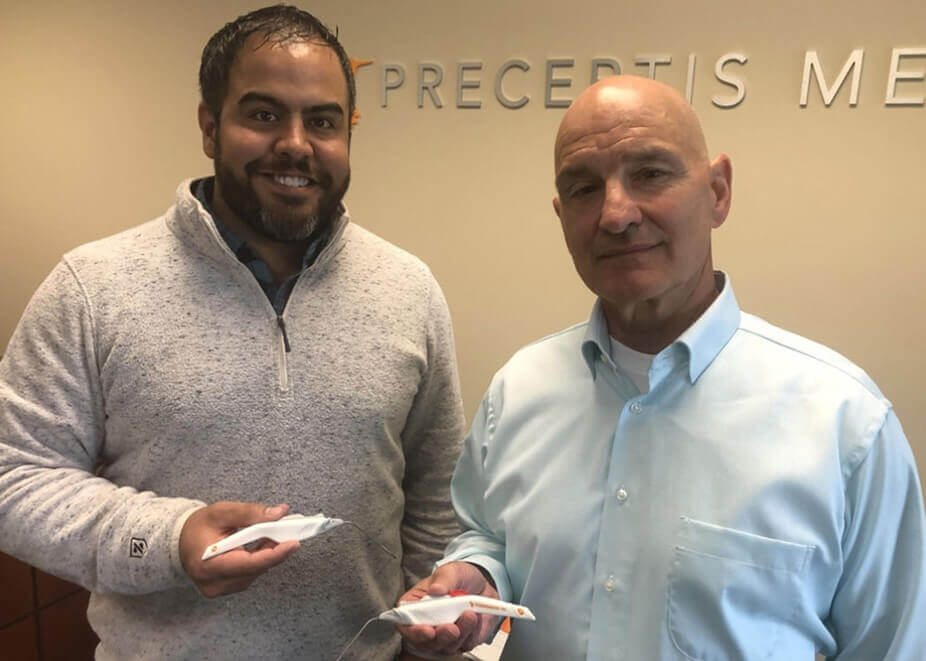
Joe Delgado, chief financial officer of Preceptis Medical, had a personal reason for leaving a good job at UnitedHealth Group a few years ago.
His daughter, Vivian, now 5 years old, benefited from a tube implanted in her ears using a Preceptis Hummingbird device. The procedure was done in a doctor’s office. No hospital operating room or anesthesia was needed. That made it far less costly than the standard procedure, which can run up to $5,000, and less worrying. Vivian previously had a set of tubes inserted in the traditional manner.
“I’ll never forget the moment we handed our 9-month-old baby to the nurse to be put under general anesthesia,” Delgado said. “It was very traumatic for me and my wife. After her tubes fell out in four months, my wife and I both wanted an alternative.
“With Preceptis, the experience was dramatically different. She recovered immediately and was smiling within a minute of the procedure being completed. That’s why I’m so passionate about what we’re doing.”
There are more than 1 million pediatric ear-tube procedures in the U.S. performed annually by ear, nose and throat (ENT) doctors, mostly in operating rooms.
But after a decade of development, including $26 million in investor capital, Preceptis is gaining traction with the device that simplifies such procedures.
A 250-child study of its procedure in 2018 and 2019 was covered in the Laryngoscope, an ENT peer-reviewed journal. The Food and Drug Administration gave clearance and the American Academy of Otolaryngology endorsed the device for in-office procedures.
“We have received orders from Health Partners, St. Cloud ENT and the Mayo Clinic,” said Steve Anderson, chief executive of Preceptis. “That being said, ear-tube procedures are down 80 to 90% this year due to COVID-19. But ENT doctors, pediatricians and Preceptis expect tube procedures to start coming back in the second quarter and return to more normal in 2022.”
The Hummingbird device, which costs less than $1,000, was invented in part by Dr. Michael Loushin, an anesthesiologist. Loushin and Anderson were neighbors in Roseville when, about 15 years ago, they started talking about alternatives to surgery for children who needed tubes for ongoing ear infections.
In 2013, Preceptis won the Minnesota Cup competition for innovative business plans, as well as an industry-technology award. However, the FDA slowed the company’s jump into office procedures. The agency required that tests first be done in operating rooms with patients under sedation, but not general anesthesia. It worked. The study in 2018 and 2019 was done by ENT surgeons in their offices without anesthesia.
“It’s an enormous cost saver,” Anderson said. “The money comes right off the top. You go from operating room to office. Everybody knows that saves money. And moms like this. That’s huge. They love this thing. Every case we do the moms and dads virtually become spokespeople for us.”
Anderson has elected to conserve capital by not hiring a sales force. Preceptis instead is working directly with several care providers, including Mayo Clinic and Health Partners, on a pilot commercialization to validate the business model.
Preceptis’ most significant competitor is Tusker Medical, which received FDA approval for a drug/device combination product in 2019. It was acquired by Smith & Nephew, a British medical device company, in 2020.
Anderson said he’s not pressured to sell the company because his investors, which include affluent individuals and a Chinese medical concern, are patient. Children’s Minnesota recently put in $1 million. He has avoided traditional venture capital.
“Our investors believe in where we are going,” Anderson said. “That we can become a standard of care.”
Maple Grove-based Preceptis designs and manufactures the product in the Twin Cities.
“Our goal now is to not raise a huge amount of capital, and hire a whole bunch of sales reps,” Anderson said. “We don’t think we need to do that. What we are doing now is a commercial pilot. We want to validate the business model and then we can decide to add representatives and grow or partner with a larger company.
“Eventually, after the commercial pilot, we may hire a sales force. Or we could be a good fit with a larger corporation.”
It’s encouraging to see a health care innovator that economically improves care.
Neal St. Anthony has been a Star Tribune business columnist and reporter since 1984. He can be contacted at nstanthony@startribune.com.